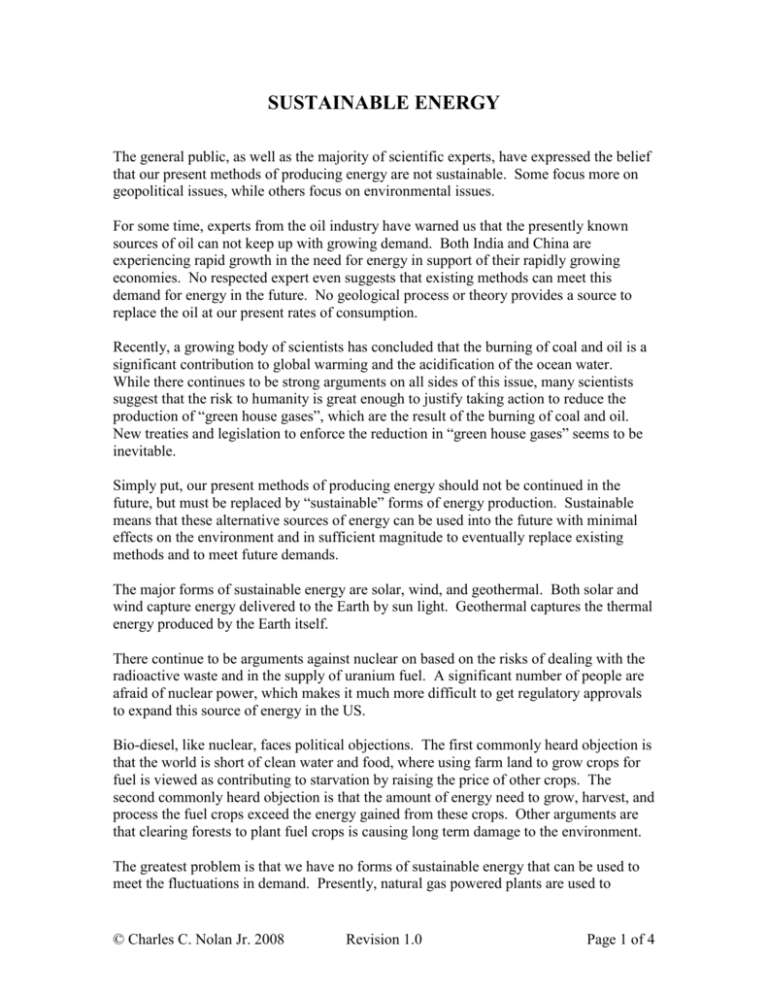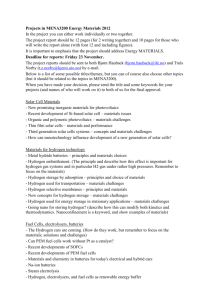Sustainable Energy white paper presented at the
advertisement

SUSTAINABLE ENERGY The general public, as well as the majority of scientific experts, have expressed the belief that our present methods of producing energy are not sustainable. Some focus more on geopolitical issues, while others focus on environmental issues. For some time, experts from the oil industry have warned us that the presently known sources of oil can not keep up with growing demand. Both India and China are experiencing rapid growth in the need for energy in support of their rapidly growing economies. No respected expert even suggests that existing methods can meet this demand for energy in the future. No geological process or theory provides a source to replace the oil at our present rates of consumption. Recently, a growing body of scientists has concluded that the burning of coal and oil is a significant contribution to global warming and the acidification of the ocean water. While there continues to be strong arguments on all sides of this issue, many scientists suggest that the risk to humanity is great enough to justify taking action to reduce the production of “green house gases”, which are the result of the burning of coal and oil. New treaties and legislation to enforce the reduction in “green house gases” seems to be inevitable. Simply put, our present methods of producing energy should not be continued in the future, but must be replaced by “sustainable” forms of energy production. Sustainable means that these alternative sources of energy can be used into the future with minimal effects on the environment and in sufficient magnitude to eventually replace existing methods and to meet future demands. The major forms of sustainable energy are solar, wind, and geothermal. Both solar and wind capture energy delivered to the Earth by sun light. Geothermal captures the thermal energy produced by the Earth itself. There continue to be arguments against nuclear on based on the risks of dealing with the radioactive waste and in the supply of uranium fuel. A significant number of people are afraid of nuclear power, which makes it much more difficult to get regulatory approvals to expand this source of energy in the US. Bio-diesel, like nuclear, faces political objections. The first commonly heard objection is that the world is short of clean water and food, where using farm land to grow crops for fuel is viewed as contributing to starvation by raising the price of other crops. The second commonly heard objection is that the amount of energy need to grow, harvest, and process the fuel crops exceed the energy gained from these crops. Other arguments are that clearing forests to plant fuel crops is causing long term damage to the environment. The greatest problem is that we have no forms of sustainable energy that can be used to meet the fluctuations in demand. Presently, natural gas powered plants are used to © Charles C. Nolan Jr. 2008 Revision 1.0 Page 1 of 4 rapidly produce energy as needed to prevent drops in voltage or shifts in frequency that occur when demand exceed the available capacity. As these conditions can cause damage to some electrical equipment, the grid shuts down in situations where the supply can not meet the demand. Hydroelectric is another form of energy production that produces no waste, but it requires the disruption of normal river flows. Existing dams will most likely continue to produce clean energy into the future, but there are very few places where new hydroelectric projects can be built in the US. While minor improvements and modernizations of existing facilities may continue into the future, hydroelectric power will not expand significantly. Wind power has become the largest source of sustainable energy after hydroelectric, but at present there is no way to store this energy to be delivered at times of peak demand. The sun heats the air, which results in winds that can be used to turn turbines. Geothermal continues to show slow growth. These projects can be expensive to build and require significantly more maintenance expenses than other forms of sustainable energy. Solar energy is directly used to heat tubes full of water. This is frequently used to either preheat water, before it is delivered to a hot water heater or to warm water for swimming pools, without additional heating. By using reflectors or lenses, solar energy can be used to produce much higher temperatures. This concentrated energy can be used to turn turbines or provide heat directly to a wide variety of purposes. Solar electric, also known as photovoltaic, can directly produce electricity from sunlight. In the past these systems were too expensive in both the costs of the solar panels and in the labor to install them, but recent innovations have made solar a cost effective addition to our sources of electrical energy. Again, there is no cost effective way to store this energy to meet peak demands. Presently, water is pumped up hill into reservoirs when power is available and allowed to run back through turbines to produce power when needed. These systems require large areas for the reservoirs and costly equipment to pump the water. The Helms Power project in California is an excellent example of this technology. While this can be considered sustainable, the costs in money and land make this unlikely as a major source of energy storage in the future. With funding from the US government, several companies are proposing the use of fly wheels that are built with new materials to store energy. While this is a new and interesting technology, it seems unlikely to be used to support grid power in a major way in the future. The initial costs and possibly complexities of these systems seem to make them unlikely as a significant method of storing grid power. © Charles C. Nolan Jr. 2008 Revision 1.0 Page 2 of 4 Hydrogen is presently used in various military and scientific projects as a means to store energy. All of the major vehicle manufacturers seem to see this as the transportation fuel of the future. Some companies are using hydrogen in modified internal combustion engines, while others are using fuel cells to produce electricity to power electric motors. The largest market for fuel cell vehicles is fork trucks, where several companies are replacing natural gas, propane, and battery powered designs with medium pressure storage of hydrogen fuel. The major advantages are the ability to quickly refill the hydrogen tanks and that the exhaust is just water vapor. The high cost of fuel cells and hydrogen storage systems is a significant barrier, but the cost of a fuel distribution system, similar to our gasoline stations, is even more of a barrier. Shell Oil seems to be ahead of the other oil companies in committing to build more hydrogen fueling stations. Hydrogen is showing up in stationary power applications, where it is being used with fuel cells to replace batteries. An early failed startup, EverWatt Inc., considered the term “water battery” to be a trade mark of their planned stationary power and fueling systems. A hydrogen fuel cell uses a special membrane to separate the electron from the proton in a hydrogen atom, allowing the electron to be used the same as from a battery, while the hydrogen is combined with oxygen from the air to make water. A fuel cell can be reversed to separate hydrogen and oxygen from pure water. This process is sometimes called regeneration. As energy can be stored by the separation of water and recovered by the re-combining of the oxygen and hydrogen to make water, we may think of this as a water battery. Hydrogen can be used to store electrical energy and then fuel cells are used to recover that stored energy. This is a simple and pollution free method of energy storage. Most of the arguments against hydrogen energy storage focus on efficiency. There are significant losses, mostly as heat, in both generating hydrogen and in using fuel cells or engines to produce power. In many cases, the cost of the equipment and cost of operating the equipment are compared to coal, oil, or natural gas, with total disregard for the environmental concerns and the increasing costs of producing oil, as the easy to recover oil reservoirs are pumped dry. The most significant competitor of hydrogen seems to be the chemical storage of energy in batteries. At this time, battery life, cost, recharge time, and weight are considered the most significant disadvantages of batteries. The need to recycle batteries to recover the heavy metals may result in significant environmental damage if these batteries are simply discarded. At one time the United States had the greatest reserves of oil. There were puddles of oil that had seeped to the surface. Today, the easy to recover, light sweet crude, has been © Charles C. Nolan Jr. 2008 Revision 1.0 Page 3 of 4 used up. One way to view this is to consider that in the beginning it took about one barrel of oil worth of energy to produce twenty barrels of oil at the well. Today, it takes one barrel of oil worth of energy to produce three barrels of oil from many older oil fields. It is important to realize that there is still a great amount of oil in the world, but the costs of extracting and processing continue to increase along with the increased demand for oil driven by the growing economies of India and China. As the easy to recover oil has been used up from the developed countries, much of the remaining oil is produced in countries which are unstable politically. In the present market, fear of interruption in supply, drives the prices ever higher. For example in Nigeria, rebels have succeeded in reducing the oil production by damaging oil production facilities and threatening the foreign personnel who are needed to maintain and operate these facilities. Increasingly, political scientists question whether the United States can maintain a high standard of living, when the US depends on oil and coal for much of our stored energy. The transition to wind and solar power with energy stored as hydrogen presents hope for a sustainable future, but much engineering needs to be done to reduce costs, while improving efficiency. Significant investments in manufacturing capacity need to be made, at a time when most large US companies are unwilling to make long term commitments to investing in manufacturing capacity. Instead, they go to countries like China where the government heavily subsidizes new manufacturing facilities. This short term thinking that infests the board rooms of the US is the same kind of short term thinking of the drug addict, who shoots up to feel good, while destroying his future. Fortunately, the US continues to produce the entrepreneurs who have taken on the task of improving the efficiency of manufacturing. Unfortunately, much of the venture capital community seems to be infested with short term thinking, rather than building companies with long term competitiveness as a core value. © Charles C. Nolan Jr. 2008 Revision 1.0 Page 4 of 4






